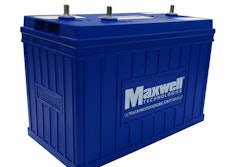 The Signature Series trailer was displayed in August at the Great American Trucking Show in Dallas.
The Signature Series trailer was displayed in August at the Great American Trucking Show in Dallas.Since I last wrote about our first- and second-generation Signature Series trucks, I’ll move to the trailer. The first trailer design is complete, and we have seven models in real-world operations. We’re working on the second generation.
Studies show potential for trailer improvements that would add one full mile per gallon. After looking at the available products and technologies on the market, I began searching for partners to help me integrate the key ones and bring the concept to market.
My primary objectives were increased fuel mileage, lower maintenance costs and long life. I started with fuel efficiency. It offers the biggest impact on the bottom line through two main areas: aerodynamic drag and rolling resistance in the tires and the mechanical components.
Years ago, after researching trailer side skirts, I found too many problems with certain products. Some can be damaged easily and expensive to maintain; it didn’t seem that any would last as long as the trailer. Some side skirts are not effective in crosswinds. Some evidence showed that side skirts decreased airflow around the wheels, brakes and hubs, leading to higher temperatures and unwanted tire wear.
Then I came across a product called an undertray system. I contacted the company, which I learned had years of experience in aerodynamic design from the aerospace and racing industries and was doing extensive testing on efficient trailer design. Not only did I settle on the undertray system for my project, but I also was able to recruit the company’s engineers to help me with the entire trailer design.

Next I needed a trailer manufacturer to complete and build the project trailer. After talking to several trailer manufacturers, I settled on a relatively unknown private trailer manufacturer, RSI, which now is owned by Con-way Freight and called Con-way Manufacturing. With my team complete, I built that first-generation trailer.
I decided on the full UT-6 Plus system from SmartTruck. The system, which incorporates six aerodynamic components, has been shown to yield significant fuel economy improvements. It’s also lightweight, rugged and durable. It has virtually no maintenance cost over the life of the trailer.
To lower mechanical and rolling resistance, axle design was critical. I used air disc brakes, an integrated tire inflation system, MicroBlue bearings and Road King premium shocks. This lowered mechanical resistance and maintenance costs and improved safety.
To improve rolling resistance, I chose Michelin X-One XTA trailer tires. This new wide-single design lowers weight and rolling resistance and also minimizes lifetime tire cost.
I finished off the design with a new composite floor that reduced weight and increased floor strength; it should last 15 years or more. Logistics posts and logistic bar organizers can be customized.
We recently debuted the trailer at the Great American Trucking Show. So far, the trailers in service and on the road are showing fuel mileage improvements of 15 percent or more over a standard trailer. If you would like more information about the Signature Trailer, as well as a list of its specs and options, follow this link.
Next I’ll cover the next-generation Signature Series Truck and Trailer combination. The first projects used proven technologies. Now it’s time to step further outside the box and test some new products and theories.












